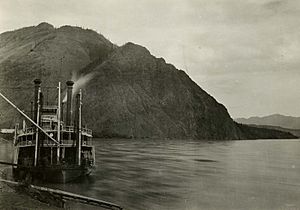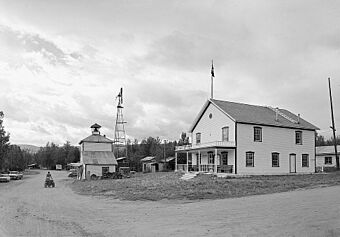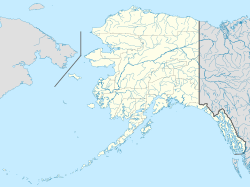Eagle, Alaska facts for kids
Quick facts for kids
Eagle, Alaska
Tthee T’äwdlenn
|
|
|---|---|

Steamer Hannah docked at Eagle circa 1900
|
|

Location of Eagle, Alaska
|
|
| Country | United States |
| State | Alaska |
| Census area | Southeast Fairbanks |
| Incorporated | February 9, 1901 |
| Area | |
| • Total | 0.88 sq mi (2.28 km2) |
| • Land | 0.88 sq mi (2.28 km2) |
| • Water | 0.00 sq mi (0.00 km2) |
| Elevation | 853 ft (260 m) |
| Population
(2020)
|
|
| • Total | 83 |
| • Density | 94.21/sq mi (36.36/km2) |
| Time zone | UTC-9 (Alaska (AKST)) |
| • Summer (DST) | UTC-8 (AKDT) |
| ZIP code |
99738
|
| Area code | 907 |
| FIPS code | 02-20380 |
| GNIS feature ID | 1401499 |
Eagle is a small village located in Alaska, United States. Its name in the Hän Athabascan language is Tthee T’äwdlenn. You can find Eagle on the south bank of the Yukon River, very close to the border between Canada and the United States.
Eagle is known for its historic area, called the Eagle Historic District. This district is so important that it's recognized as a U.S. National Historic Landmark. In 2010, about 86 people lived here. Every February, Eagle is a stop for the exciting Yukon Quest sled dog race, which covers a very long distance.
Contents
Geography of Eagle, Alaska
Eagle is located at coordinates 64°47′10″N 141°12′0″W / 64.78611°N 141.20000°W. It's about 5.9 miles (9.5 km) west of the border with Canada's Yukon Territory.
The village sits on the southern bank of the Yukon River. It's also at the end of the Taylor Highway, a road that connects to the area. Eagle is very close to the Yukon–Charley Rivers National Preserve, a large protected natural area.
The United States Census Bureau says that Eagle covers about 1.0 square mile (2.6 square kilometers) of land. There is no water area within the city limits.
Climate in Eagle
Eagle has a subarctic climate, which means it has very long, cold, and dry winters. Sometimes, warm winds called Chinook winds can make the winter a bit milder. However, without these winds, winter temperatures can be extremely cold and dangerous. For example, in December 1917, the temperature stayed below -25°F (-32°C) and averaged -46°F (-43°C)!
Summers in Eagle are short and warm. Even in winter, Chinook winds can sometimes push temperatures above 32°F (0°C), which happens about five days each winter.
| Climate data for Eagle, Alaska (1991–2020 normals, extremes 1901–present) | |||||||||||||
|---|---|---|---|---|---|---|---|---|---|---|---|---|---|
| Month | Jan | Feb | Mar | Apr | May | Jun | Jul | Aug | Sep | Oct | Nov | Dec | Year |
| Record high °F (°C) | 50 (10) |
57 (14) |
59 (15) |
74 (23) |
91 (33) |
97 (36) |
95 (35) |
93 (34) |
80 (27) |
69 (21) |
51 (11) |
53 (12) |
97 (36) |
| Mean maximum °F (°C) | 30.4 (−0.9) |
35.2 (1.8) |
44.7 (7.1) |
60.6 (15.9) |
78.6 (25.9) |
86.4 (30.2) |
86.8 (30.4) |
81.1 (27.3) |
68.4 (20.2) |
51.1 (10.6) |
32.8 (0.4) |
32.0 (0.0) |
88.6 (31.4) |
| Mean daily maximum °F (°C) | 1.0 (−17.2) |
12.0 (−11.1) |
23.7 (−4.6) |
44.8 (7.1) |
61.7 (16.5) |
72.2 (22.3) |
73.3 (22.9) |
66.9 (19.4) |
54.6 (12.6) |
33.5 (0.8) |
12.7 (−10.7) |
6.5 (−14.2) |
38.6 (3.7) |
| Daily mean °F (°C) | −7.7 (−22.1) |
0.9 (−17.3) |
8.7 (−12.9) |
29.8 (−1.2) |
45.9 (7.7) |
56.5 (13.6) |
59.2 (15.1) |
53.1 (11.7) |
42.0 (5.6) |
24.7 (−4.1) |
4.5 (−15.3) |
−2.1 (−18.9) |
26.3 (−3.2) |
| Mean daily minimum °F (°C) | −16.4 (−26.9) |
−10.2 (−23.4) |
−6.4 (−21.3) |
14.8 (−9.6) |
30.2 (−1.0) |
40.8 (4.9) |
45.0 (7.2) |
39.3 (4.1) |
29.4 (−1.4) |
15.8 (−9.0) |
−3.7 (−19.8) |
−10.8 (−23.8) |
14.0 (−10.0) |
| Mean minimum °F (°C) | −50.4 (−45.8) |
−43.2 (−41.8) |
−33.9 (−36.6) |
−9.7 (−23.2) |
19.8 (−6.8) |
33.5 (0.8) |
37.9 (3.3) |
28.6 (−1.9) |
17.1 (−8.3) |
−5.7 (−20.9) |
−29.4 (−34.1) |
−41.0 (−40.6) |
−53.2 (−47.3) |
| Record low °F (°C) | −71 (−57) |
−67 (−55) |
−58 (−50) |
−30 (−34) |
−1 (−18) |
20 (−7) |
25 (−4) |
18 (−8) |
−7 (−22) |
−37 (−38) |
−54 (−48) |
−69 (−56) |
−71 (−57) |
| Average precipitation inches (mm) | 0.34 (8.6) |
0.25 (6.4) |
0.18 (4.6) |
0.32 (8.1) |
0.94 (24) |
1.81 (46) |
2.80 (71) |
1.87 (47) |
1.39 (35) |
0.77 (20) |
0.43 (11) |
0.38 (9.7) |
11.48 (291.4) |
| Average snowfall inches (cm) | 8.0 (20) |
8.0 (20) |
6.1 (15) |
3.1 (7.9) |
1.0 (2.5) |
0.0 (0.0) |
0.0 (0.0) |
0.0 (0.0) |
1.3 (3.3) |
11.1 (28) |
12.1 (31) |
12.0 (30) |
62.7 (157.7) |
| Average precipitation days | 6.7 | 4.2 | 3.9 | 4.4 | 9.4 | 11.6 | 16.6 | 15.1 | 11.2 | 8.1 | 6.5 | 7.8 | 105.5 |
| Average snowy days (≥ 0.1 in) | 5.6 | 4.9 | 3.8 | 1.9 | 0.6 | 0.0 | 0.0 | 0.0 | 0.9 | 6.3 | 7.5 | 7.1 | 38.6 |
| Source 1: NOAA (snow/snow days 1981–2010) | |||||||||||||
| Source 2: National Weather Service | |||||||||||||
History of Eagle
For thousands of years before Europeans arrived, the area around Eagle was home to many indigenous peoples, including the Han.
Around 1874, the first known American-built trading post, called "Belle Isle," was set up in Eagle. In the late 1800s, Eagle became a very important place for miners. It was a center where they could get supplies and trade goods while working along the upper Yukon River. By 1898, Eagle's population grew to over 1,700 people. Many new people came to the area because of the Klondike Gold Rush.
In 1901, Eagle became the first official city in the Alaska Interior. It was named "Eagle" because many eagles built their nests on a nearby cliff called Eagle Bluff. A United States Army camp, Fort Egbert, was built in Eagle in 1900. A telegraph line, which is like an old-fashioned telephone line, was finished in 1903. This line connected Eagle to Valdez. In 1905, a famous explorer named Roald Amundsen arrived in Eagle. From there, he sent a telegram to the world, announcing that he had successfully sailed through the Northwest Passage.
Later, new gold rushes happened in places like Nome and Fairbanks. This caused many people to leave Eagle. In 1903, a judge named James Wickersham moved the main court from Eagle to Fairbanks. By 1910, Eagle's population had dropped to fewer than 200 people, similar to what it is today. Fort Egbert was closed in 1911.
Today, most people living in Eagle are of European descent. However, nearby Eagle Village has a small population where about half the people are Han.
Eagle also gained some fame as the setting for a popular book called Coming into the Country by John McPhee, first published in 1977. Many of the old buildings from the Gold Rush days are still standing. They are protected as part of the Eagle Historic District, which is a National Historic Landmark.
The Eagle area is also featured on the National Geographic Channel TV show Life Below Zero.
Population of Eagle
| Historical population | |||
|---|---|---|---|
| Census | Pop. | %± | |
| 1900 | 383 | — | |
| 1910 | 178 | −53.5% | |
| 1920 | 98 | −44.9% | |
| 1930 | 54 | −44.9% | |
| 1940 | 73 | 35.2% | |
| 1950 | 55 | −24.7% | |
| 1960 | 92 | 67.3% | |
| 1970 | 36 | −60.9% | |
| 1980 | 110 | 205.6% | |
| 1990 | 168 | 52.7% | |
| 2000 | 129 | −23.2% | |
| 2010 | 86 | −33.3% | |
| 2020 | 83 | −3.5% | |
| U.S. Decennial Census | |||
Eagle first appeared on the U.S. Census in 1900 as "Eagle City." It officially became a city the next year. In later censuses, its name was shortened to "Eagle."
According to the census from 2000, there were 129 people living in Eagle. These people lived in 58 households, and 37 of those were families. The population density was about 128 people per square mile (50 people per square kilometer).
Most of the people in Eagle in 2000 were White (93.02%). About 6.20% were Native American. A small number (0.78%) were from two or more racial backgrounds. Also, 0.78% of the population identified as Hispanic or Latino.
In terms of age, about 24.8% of the population was under 18 years old. The median age was 44 years. This means half the people were younger than 44 and half were older.
Education in Eagle
In the 1970s, high school students in Eagle often took correspondence courses. These were like home-study programs from the University of Nebraska-Lincoln. A local adult would help supervise their schoolwork.
Today, Eagle is part of the Alaska Gateway School District. Students in Eagle attend Eagle School, which teaches children from kindergarten all the way through 12th grade.
Eagle Historic District
|
Eagle Historic District
|
|

The former federal courthouse
|
|
| Location | Roughly the town of Eagle and the area of Fort Egbert |
|---|---|
| Area | 2,400 acres (970 ha) |
| Built | 1898 |
| NRHP reference No. | 06000435 |
| Significant dates | |
| Added to NRHP | October 27, 1970 |
| Designated NHLD | June 2, 1978 |
The Eagle Historic District is a special place that shows how Northern Alaska developed over time. Fort Egbert was built in 1889 to be a central government center for the area. More than 100 buildings from that time are still standing today. This includes the old federal courthouse.
The district was added to the National Register of Historic Places on October 27, 1970. It was then named a National Historic Landmark on June 2, 1978.
Notable Person
- Charlie Fisher (baseball) - A person who was connected to Eagle.
See also
 In Spanish: Eagle (Alaska) para niños
In Spanish: Eagle (Alaska) para niños



